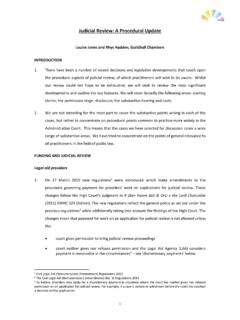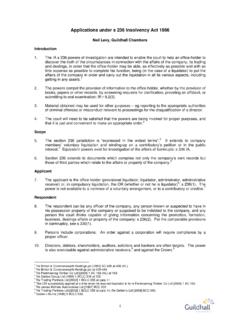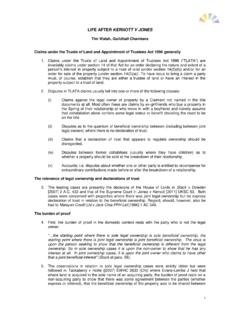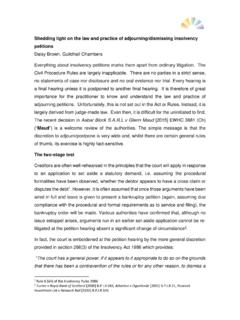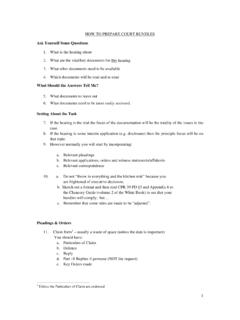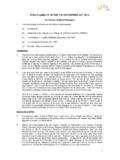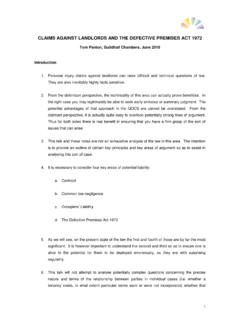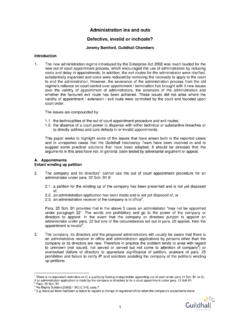Transcription of LIFTING, PIERCING AND SIDESTEPPING THE CORPORATE …
1 lifting , PIERCING AND SIDESTEPPING THE CORPORATE VEIL. James Wibberley, Guildhall Chambers & Michelle Di Gioia, Gardner Leader 1. Limited liability companies provide huge commercial benefits for businessmen, but even larger headaches for lawyers when they are forced to explain to lay clients how wealthy individuals can hide behind the veil of incorporation when a business deal goes south. This is, if anything, a growing problem as individuals and their accountants become increasing sophisticated at manipulating CORPORATE structures to avoid the consequences of litigation in the same way they do tax. The worst offenders are those, such as directors, who seek to use limited companies to avoid personal obligations and liabilities. 2. This talk aims to explore the extent to which the difficulties posed by the CORPORATE veil can be overcome.
2 This includes not simply pursuing individuals or parent companies seeking to avoid their legal obligations, but also actions against those who drive litigation for their own purposes then hide behind CORPORATE entities when their claim or defence fails. 3. In order to address this variety of situations, this talk is divided into two sections. The first looks at the law in relation to lifting and PIERCING following the recent decision of the Supreme Court in Prest v Petrodel Resources Limited [2013] UKSC 34. The second looks at what we have entitled SIDESTEPPING the CORPORATE veil, namely the court's jurisdiction to make non-party costs orders under the provisions of section 51 of the Senior Courts Act 1981. Whilst the first part of the talk will highlight the difficulties in establishing liability through the CORPORATE facade, the second will hopefully show that those who seek to engage in litigation from the sidelines are not as safe as they might assume.
3 The CORPORATE Veil the law pre-Prest 4. The concept of the CORPORATE veil dates back to the landmark decision of the House of Lords in Salomon v A Salomon and Co Ltd [1897] AC 22, where the legal separation between a company and its shareholders was established. In the view of Lord Halsbury LC, a limited company was to be viewed like any other independent person with its rights and liabilities appropriate to itself . More recently in Bank of Tokyo Ltd v Karoon (Note) [1987] AC 45, Robert Goff LJ confirmed the different between commercial reality and legal principle stating that we are concerned not with economics but with law. The distinction between the two is fundamental . 5. Despite the importance of this distinction, the courts have always been wary that there must be some limit to the protection afforded by limited liability in order to ensure that business dealings remain honest.
4 Just a free market economy relies upon the role of limited liability companies (they allow individuals to take economic risks that they otherwise might not), it also relies on a degree of fairness in the dealings. This was recognised in the dicta of Denning LJ in Lazarus Estates Ltd v Beasley [1956] 1 QB 702, where he said at page 712 that: No court in this land will allow a person to keep an advantage which he had obtained by fraud. No judgment of a court, no order of a Minister, can be allowed to stand it if has been obtained by fraud. Fraud unravels everything. The court is careful not to find fraud unless it is distinctly pleaded and proved; but once it is proved, it vitiates judgments, contracts and all transactions . 6. It is this statement of principle that underpinned all of the early attempts to pierce the CORPORATE veil; the court would not allow a CORPORATE personality to be used to protect individuals from wrongdoing.
5 Fraudulent actions would not be protected, nor would those where the limited company was simply being used as a facade or a sham. 7. It is important to emphasise that burden of proving fraud is a heavy one, and that allow the court to interfere with the CORPORATE veil simply to prevent unjust results. This was acknowledged by Lord Keith of Kinkel in Woolfson v Strathclyde Regional Council 1978 1. (HL) 90, where he commented at page 96 that it is appropriate to pierce the CORPORATE veil only where special circumstances exist indicating that it is a mere facade concealing the true facts . 8. A similar comment was made by Slade LJ in Adams v Cape Industrial Plc [1990] CH 433, commonly regarded as one of the leading cases on the principle of PIERCING the CORPORATE veil. Although circumstances would often arise where it would be unfair for an individual to be able to take advantage of the CORPORATE veil, that alone would not be enough for the court to take action (see page 536).
6 The court is not free to disregard the principle of Solomon v A Solomon & Co Ltd [1897] AC. 22 merely because it considers that justice so requires. Our law, for better or worse, recognises the creation of subsidiary companies, which though in one sense the creatures of their parent companies, will nevertheless under the general law fall to be treated as separate legal entities with all the rights and liabilities which would normally attach to separate legal entities.. 9. The strictness of this approach led to a principle of PIERCING the CORPORATE veil that existed more as a matter of legal theory than it did a feature of legal practice. Judges were clear when the veil could not be pierced, but, absent a clear case of fraud, less clear about when they could. The leading cases, such as the decision in Munby J in Ben Hashem v Al Shayif [2009] 1 FLR.
7 11, seemed to pose more questions than they answered in terms of when the principle could be applied. 10. This confusion is perhaps best illustrated by the decision of Sir Andrew Morritt V-C in AB v Smallbone (No 2) [2011] 1 WLR 1177, where he sought to classify the circumstances in which the veil could be pierced as those where (i) the company was a sham or (ii) it was involved in some form of impropriety. As with a test of fraud though, Sir Andrew's formulation is difficult to apply. In what circumstances is a company a sham? Must it be established for a sham purpose or can a legitimate company become a sham company in certain circumstances? Most significantly, what constitutes impropriety for these purposes? Did the company need to be doing something illegal or would simple immorality suffice? In what circumstances would a company have the illegal or immoral actions of an individual imputed to it?
8 11. These principles then marked the state of the law in relation to PIERCING the CORPORATE veil preceding the decision in Prest. Practice in the Family Division 12. Before moving on to consider the decision in Prest, a few brief comments are needed about the practice within the Family Division of the High Court during the development of the line of case law discussed above. The need for this discussion will be evidence from the facts in Prest. 13. Whilst it was commonly accepted within the Chancery Division that the interests of justice were not a sufficient basis for seeking to pierce the CORPORATE veil, the Family Division took the opposite view. From the mid 1980s onwards it became common for the CORPORATE veil to be pierced in ancillary relief proceedings due to concern about divorcing spouses (usually the husbands) seeking to conceal their assets.
9 In cases such as Green v Green [1993] 1 FLR 326. and Mubarak v Mubarak [2001] 1 FLR 673, orders were made against company property when it was just and necessary to do so. 14. Bizarrely, different divisions of the High Court had adopted contradictory approaches to the same problem. One viewed the concept with suspicion (some even doubting that it in fact existed). The other would happily embrace it when the interests of justice so required. Prest v Petrodel Resources Limited 15. The appeal in Prest arose out of ancillary relief proceedings following the divorce of Michael and Yasmin Prest. Those names might be familiar to some of those reading theses notes as the actions of multi-millionaire oil tycoon Mr Prest received the attention of the national media between 2008 and 2011. Although the division of assets was itself simple enough (Moylan J.)
10 2. awarded Mrs Prest million plus 24,000 per annum and the school fees of the four children) those assets, mainly in the form of residential property, were held by various companies owned and controlled by Mr Prest. Throughout the proceedings, Mr Prest argued that as the companies were not being used for any improper purposes (the properties were held by the companies for tax purposes long in advance of the divorce) the properties could not be touched due to the operation of the CORPORATE veil. 16. At first instance, Moylan J ordered both Mr Prest and the seven companies he controlled to transfer the matrimonial home and a further seven properties into Mrs Prest's name. He also made three of the companies jointly and severally liable for 10% of Mrs Prest's legal costs. Interestingly though, the judge reached these decisions not on the basis of PIERCING the CORPORATE veil (he accepted the argument that this was something he could not do absent clear impropriety), but concluding that he had a wider discretion under section 24 of the Matrimonial Causes Act 1973.

